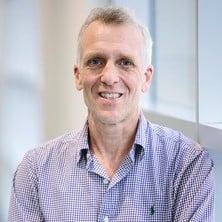
Professor Robert G Parton
Institute for Molecular Bioscience, University of Queensland
- 11:00
- via Zoom. Details to be email on seminar day,
- Dr Jennifer Zenker
New Insights into the Structure and Function of Caveolae
Abstract
Caveolae are the most abundant features of the plasma membrane of many vertebrate cells. The surface of endothelial cells, adipocytes, skeletal muscle, and many other cell types is densely covered by these small invaginations. The diverse roles of caveolae in different cell types are still controversial but caveolae have been implicated in transendothelial transport, lipid regulation, signal transduction, and mechanoprotection. The major membrane proteins of caveolae are small integral membrane proteins called caveolins. In vertebrate cells, caveolins work together with lipid-binding peripheral membrane proteins termed cavins. We have shown that Cavin1 is essential for caveola formation, and we have proposed a model in which multiple electrostatic ‘fuzzy’ interactions between cavins, caveolins, and membrane lipids (such as cholesterol, phosphatidylserine and PtdIns(4,5)P2) generate caveolae. The resulting caveolar domain is sensitive to mechanical perturbation and to oxidative stress. Disassembly of caveolae caused by increased membrane tension or other stress conditions releases cavins into the cell allowing interactions with diverse intracellular targets to trigger cellular responses. These results highlight a critical role for caveolae and the caveolin-cavin system as protective and stress signaling elements of the plasma membrane.
Bio
Rob Parton studied biochemistry in the UK before moving to the European Molecular Biology Laboratory in Heidelberg, Germany. He received Royal Society and EMBO postdoctoral fellowships before becoming an EMBL junior group leader (Staff Scientist) studying endocytosis. In 1996, he moved to the University of Queensland, Brisbane, Australia. He is currently a group leader and Division Head (Cell and Developmental Biology) in the Institute for Molecular Bioscience and Deputy Director of the Centre for Microscopy and Microanalysis. He holds a Senior Principal Research Fellowship from the National Health and Medical Research Council of Australia and is a Fellow of the Australian Academy of Science.
